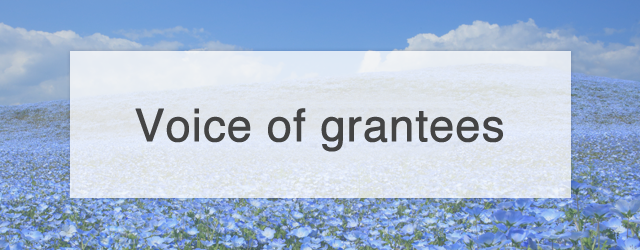HOME > List of Voice of grantees > Development of visualizing devices to understand the dynamic life by light
Development of visualizing devices to understand the dynamic life by light"Creation of Industrial Infrastructure" 5th Grant Period: April 2014–May 2015
Details of research conducted during the grant period
A High-resolution 8KCMOS Sensor for the Living Body Enabling Wide-view, High-resolution In-vivo Visualization
A CMOS sensor with a large number of pixels — of the type commonly used in digital cameras — is used in order to visualize the inside of the body and facilitate understanding. This research is intended to achieve visualization of the inside of a living body without dissection.
It is likely that I am the only researcher in the field of basic biology using a Canon 8KCMOS sensor at present. I think my research is closely linked to Canon and its development of medical equipment.
As a result of my work, I succeeded in conducting wide-view, high-resolution visualization of the inside of a mouse body with an ultra-high-tech and revolutionary method incorporating the 8KCMOS sensor. (Image)
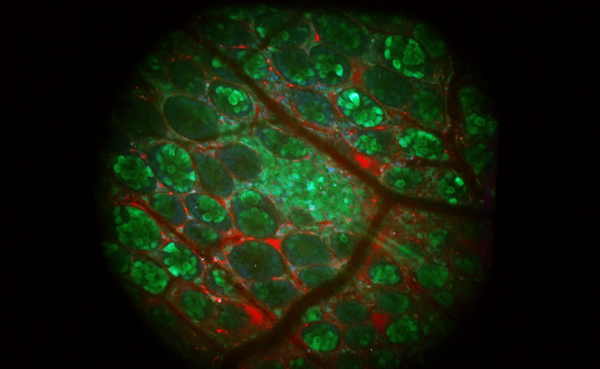 Intestinal villi
Intestinal villi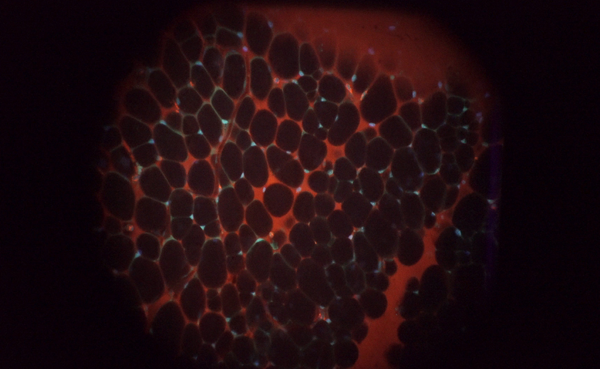 Adipose tissue
Adipose tissueProgress and development following the research funding period
Development of a Technology Incorporating a Miniaturized Sensor for Skin Diagnosis
Basic biology is not limited to the development of large systems. The medical field is also in need of small systems. We have developed a small device that provides high resolution theoretically equal to that of a room-sized microscope, and we have begun to develop applications for the field of skin diagnosis.
For example, dermatologists use a diagnostic instrument called a dermoscope, a device similar to a magnifying glass, to observe skin moles and the like, but the target is sometimes difficult to see clearly. The image does not differ from that taken with a close-up lens of a conventional camera. On the other hand, the spatial resolution of an instrument incorporating our compact system is equivalent to that of microscope, which enables the interior of each cell to be clearly seen. Thus, this system can considerably improve the accuracy of a cancer diagnosis compared with the conventional method of observing the surface of the skin. Furthermore, this system allows for infinite adjustment of the magnification and focal distance, resulting in a highly versatile system. We are currently conducting clinical trials with a dermatologist.
In addition, as an example of the capacity to expand the wavelength range, we are developing an infrared microscope. By using the mid-infrared and near-infrared ranges, we can see the target as if it has been dyed, even though it is not actually dyed in the body.
What inspired you to undertake this study?
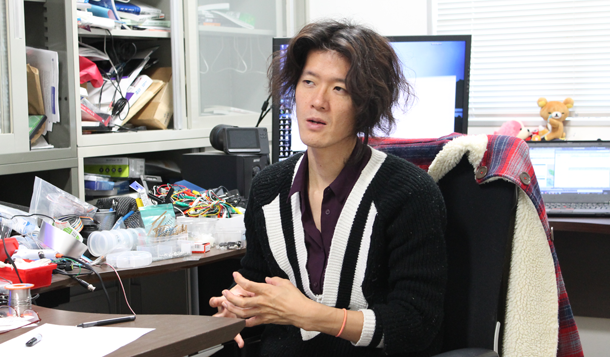
I studied in a medical faculty and gained experience in the use of heart catheters for cardiological treatment of myocardial infarction and the like. I began my biology studies in 2004, and I decided to focus on cameras and shooting methods about ten years ago. I used microscopes frequently during my classical studies, for example, on how the heart functions. However, in 2004 microscopes did not have the same performance they have now. At that time, I tried to develop a variety of my own microscopes by learning from others.
Since my days at junior and senior high school, I was good at designing things, so I can write software and develop some components by myself. When I began studying hand-made imaging systems with the advantage of mounting speed, some people requested that I image various body parts. In addition, makers of optical equipment requested that I use their sensors, so I assisted them with research and development. As for what inspired me to undertake this research, it was a way for me to give back to the world by developing something of value in addition to my medical research.
Were there any interesting incidents after your research began?
Holding classes for elementary, junior high and senior high school students about how to make things
I teach students in middle and upper grades of elementary schools how to make things. Instead of, for example, just purchasing a radio controller for them, it can be a form of education to teach the children how to make such things from scratch. In recent years, most children have not been taught how to use tools, so I find it interesting that they can come up with some excellent designs in unexpected ways. Also, I disassemble inexpensive drones into their component parts so the children can see how the modules operate. Even gyroscopic sensors can function after being disassembled. If the drone can fly in this state, the children can easily understand how the drone is able to fly.
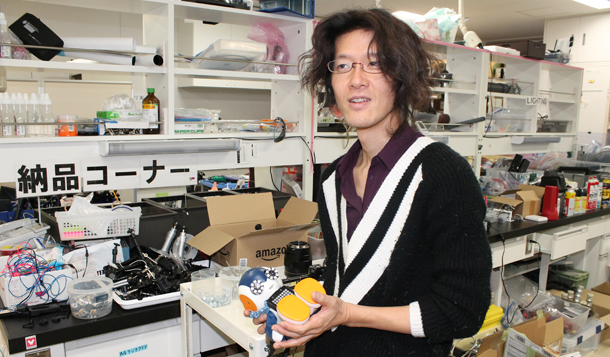
I give classes that enable children to understand familiar technologies so that they can use them themselves. I negotiate with schools by myself, as this is not a project introduced by the university. Making the children happy in this way I consider to be my social responsibility.
During my lifetime, I have spent an inordinate amount of time creating things, so my next commitment is to talk with people. In the year before last, I adopted the goal of giving out 1,000 of my business cards each year. Three years ago, I gave out 1,500. I talk with about 10 people every day, so I am spending more and more time doing this. I like setting numerical goals for myself.
Currently, the numerical goal of many researchers is the impact score of their research papers. In recent years, however, it is seldom that a research paper changes the world. When I was wondering how I could change the world through a research paper, I hit on the idea that I should talk with people more. I find it interesting to meet people.
What are your dreams for the future?
I write down my ideas in a few notebooks every month, and I frequently review them. Once I invent something, I try it out by integrating it into a system. However, in only a few cases did it work out well when included something in this way, or when it was patented or adopted by a business. I like trying out my ideas by actually including them in systems. They resemble the dream tools from the Doraemon animation. Some people set up very challenging goals, but I don't adopt clear future plans. My dream is only to continue satisfying my curiosity.
Finally, what do you hope to see in the future?
Once you decide what you want to see first, you can almost always achieve it to do your best. The hardest thing is when you don't really have a vision. For some reason I don't know what to do now. Currently we are doing research that gathers a lot of information from one animal or person in real time. In other words, my research involves widening the communication lines between the observer (me) and the living thing. I frequently wonder what will happen when these lines widen to the maximum.
A lot of information involves animal welfare. I'm proud that my research involves an extremely small number of animals. That's because my system obtains many samples and many images from a single animal. By obtaining a lot of information from a few animals, we can reduce the number of animals used in experiments.
I intend to devise tools that enable us to understand not only images but also the entire living thing, including feelings, fate and everything.

Profile
Satoshi Nishimura
Professor, Molecular Medicine Dept., Center for Molecular Medicine, Jichi Medical University

